Reliable, resilient, redundant: Why infrastructure will make or break the electric vehicle transition
Australia’s shift to electric vehicles (EVs) has long been overshadowed by that of counterparts like the United States and the United Kingdom. But this year, we’re seeing a national shift1 – one that brings an invaluable opportunity to make Australia a prominent player in transport decarbonisation.
Author: Matthew Walden, Alina Dini
The new Labor government has signalled a genuine commitment to growing the EV market locally, where 45 models (and 95 variants) are now available with more on the way.2 The investment stream is also steady with public support from the likes of Mike Cannon-Brookes through is targeted fund, Boundless. And with total new EV sales tipping 4% of new car sales (up from 2% in 2021), the stars are aligning for Australia to fully embrace EVs in the coming years.
But to achieve this powerhouse status, we need EVs to become mainstream – an impossible outcome without reliable, resilient and redundant infrastructure to underpin it. In its absence, we cannot unlock consumer adoption of EVs.
Reliable
Motorists want to know that when they pull up to an EV charger, it will be functional and ready for use. They also want to be able to plan day-to-day and destination travel without needing to unduly consider route planning and de-risking. Reliability is a cornerstone of consumer confidence.
Resilient
Charging infrastructure needs to be resilient to external shocks, whether caused by the weather, natural disasters or technical failures. If chargers regularly fail or can’t meet demand, consumers will remain wary of the technology and hesitant to adopt it.
Redundant
To be truly functional, the infrastructure network also needs to be redundant. Consumers will feel most secure and confident when there’s a healthy level of options to access a network and no risk to supply availability, especially in an energy market transitioning to renewables. Knowing that choice is at the core of the service offering, EV infrastructure should be no different to mobile or internet networks – so ubiquitous that routine access is not the exception, but the rule.
Without high confidence in EVs, we cannot make the transition. A 2022 global survey found that consumers are most concerned about the driving range limitations and lack of public electric vehicle charging infrastructure.3 Unless these anxieties are alleviated, consumers are unlikely to consider an electric model for their next vehicle.
Prioritising Decarbonisation
Juicing up cars with renewable energy isn’t a new concept. But with the government’s renewed commitment to decarbonisation – setting a 43 percent reduction target by 20304 – there’s much work to be done across all sectors to get there.
With light vehicles and heavy trucks responsible for 82% of Australia’s total transport emissions, the transition to an all-electric fleet is essential. Even heavy vehicles will need to be electrified: relying on offsets will be highly risky considering the competing demand from aviation, agriculture and other areas of the economy.5
Meeting emissions targets isn’t the only reason to decarbonise our fleet: maintaining our current approach to road transport could cost Australia $865 billion between 2022 and 2050. In contrast, electrification could save the economy between $233 billion and $492 billion in avoided costs, depending on the speed of EV uptake.6
Despite this clear need to transition, government policy is lagging, consumer uptake remains low, and network inconsistency issues like black spots, broken chargers, poor coverage and under-served regional areas are affecting confidence in EVs.
The role of the energy transition
Though these issues have solutions, they rely on the strength and adaptation of the wider energy network. For example, a given site typically needs a dedicated transformer to deliver ultrafast charging to multiple vehicles.7 The widespread rollout of energy infrastructure will therefore require a timely and coordinated effort from an array of stakeholders.
In addition to these network inconsistencies, first-generation charging technologies aren’t sophisticated enough to meet consumer expectations, resulting in issues with quality and functionality. This includes long charging times, which Australian consumers rank as their third-highest concern about EVs.8 Consumers also have a right to expect more reliable public charging infrastructure, which is suffering for several reasons:9
- A lack of ongoing maintenance of equipment in public sites often leaves chargers out of service for long periods
- Conflict in Europe and the ongoing pandemic have interrupted supply of charging hardware and supporting components, including spare parts, leading to longer repair times even when the budget is available
- In Australia, 70% of public charging sites only have one charger, which can create queues or force drivers to go elsewhere if the charger is under maintenance or out of service.
To successfully transition to EVs, we need to consider the overall experience through the lens of the consumer. Without addressing their concerns and uncertainties, confidence will not improve and adoption will plateau. A consumer-focused action plan to build out the charging infrastructure is the only way to build confidence and create the reliable, resilient and redundant infrastructure network needed to make this future our reality.
References
[1] Rachel Lynskey, Helen Rowe and Mudabber Ashfaq, Accelerating EV uptake: Policies to realise Australia’s electric vehicle potential, Climateworks Centre, 2022, p. 8.
[2] Electric Vehicle Council, State of Electric Vehicles: October 2022, 2022, p.12.
[3] Deloitte, 2022 Global Automotive Consumer Study: Key Findings, 2022, p. 10.
[4] Tony Wood, Alison Reeve and James Ha, Towards net zero: Practical policies to reduce transport emissions, 2021, p. 15, 30.
[5] Tony Wood, Alison Reeve and James Ha, Towards net zero: Practical policies to reduce transport emissions, 2021, p. 15, 30.
[6] Deloitte, Local community benefits of Zero Emission Vehicles in Australia, 2021, p. 6.
[7] Electric Vehicle Council, State of Electric Vehicles: October 2022, 2022, p. 19|[8] Deloitte, 2022 Global Automotive Consumer Study: Key Findings, 2022, p. 10.
[9] Electric Vehicle Council, State of Electric Vehicles: October 2022, 2022, p. 15-16.


